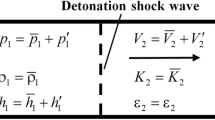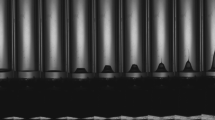Abstract
The reflection of a triple-shock configuration was studied numerically in two dimensions using the Navier–Stokes equations. The flow field was initialized using three shock theory, and the reflection of the triple point on a plane of symmetry was studied. The conditions simulated a stoichiometric methane-oxygen detonation cell at low pressure on time scales preceding ignition when the gas was assumed to be inert. Viscosity was found to play an important role on some shock reflection mechanisms believed to accelerate reaction rates in detonations when time scales are small. A small wall jet was present in the double Mach reflection and increased in size with Reynolds number, eventually forming a small vortex. Kelvin–Helmholtz instabilities were absent, and there was no Mach stem bifurcation at Reynolds numbers corresponding to when the Mach stem had travelled distances on the scale of the induction length. Kelvin–Helmholtz instabilities are found to not likely be a source of rapid reactions in detonations at time scales commensurate with the ignition delay behind the Mach stem.







Similar content being viewed by others
References
Hornung, H.: Regular and Mach reflection of shock waves. Ann. Rev. Fluid Mech. 18, 33–58 (1986)
Ben-Dor, G.: Shock Wave Reflection Phenomena. Springer, New York (2007)
Subbotin, V.: Collision of transverse detonation waves in gases. Combust. Explo. Shock 11(3), 411–414 (1975)
Gamezo, V.N., Desbordes, D., Oran, E.S.: Formation and evolution of two-dimensional cellular detonations. Combust. Flame 116(1), 154–165 (1999)
Austin, J.M.: The Role of Instability in Gaseous Detonation. PhD Thesis, California Institute of Technology (2003)
Strehlow, R.A.: Detonation structure and gross properties. Combust. Sci. Technol. 4(1), 65–71 (1971)
Radulescu, M., Sharpe, G., Lee, J., Kiyanda, C., Higgins, A., Hanson, R.: The ignition mechanism in irregular structure gaseous detonations. Proc. Combust. Inst. 30(2), 1859–1867 (2005)
Bhattacharjee, R.R.: Experimental Investigation of Detonation Re-initiation Mechanisms Following a Mach Reflection of a Quenched Detonation. Master’s Thesis, University of Ottawa (2013)
Teodorczyk, A.: Fast deflagrations and detonations in obstacle-filled channels. J. Power Technol. 79 (1995)
Ohyagi, S., Obara, T., Hoshi, S., Cai, P., Yoshihashi, T.: Diffraction and re-initiation of detonations behind a backward-facing step. Shock Waves 12(3), 221–226 (2002)
Obara, T., Sentanuhady, J., Tsukada, Y., Ohyagi, S.: Reinitiation process of detonation wave behind a slit-plate. Shock Waves 18(2), 117–127 (2008)
Lau-Chapdelaine, S.: Numerical Simulations of Detonation Re-initiation Behind an Obstacle. Master’s Thesis, University of Ottawa (2013)
Lv, Y., Ihme, M.: Computational analysis of re-ignition and re-initiation mechanisms of quenched detonation waves behind a backward facing step. Proc. Combust. Inst. 35(2), 1963–1972 (2015)
Sorin, R., Zitoun, R., Khasainov, B., Desbordes, D.: Detonation diffraction through different geometries. Shock Waves 19(1), 11–23 (2009)
Ziegler, J.L.: Simulations of compressible, diffusive, reactive flows with detailed chemistry using a high-order hybrid WENO-CD scheme. PhD Thesis, California Institute of Technology (2012)
Maley, L., Bhattacharjee, R., Lau-Chapdelaine, S.M., Radulescu, M.I.: Influence of hydrodynamic instabilities on the propagation mechanism of fast flames. Proc. Combust. Inst. 35(2), 2117–2126 (2015)
Mach, P., Radulescu, M.: Mach reflection bifurcations as a mechanism of cell multiplication in gaseous detonations. Proc. Combust. Inst. 33(2), 2279–2285 (2011)
Glaz, H., Colella, P., Glass, I., Deschambault, R.: A detailed numerical, graphical, and experimental study of oblique shock wave reflections. Technical Report LBL-20033, Lawrence Berkeley National Laboratory (1985)
Sun, M., Takayama, K.: A note on numerical simulation of vortical structures in shock diffraction. Shock Waves 13(1), 25–32 (2003)
Radulescu, M.I., Sharpe, G.J., Law, C.K., Lee, J.H.: The hydrodynamic structure of unstable cellular detonations. J. Fluid Mech. 580, 31–81 (2007)
Sharpe, G.J.: Transverse waves in numerical simulations of cellular detonations. J. Fluid Mech. 447, 31–51 (2001)
Hu, X., Zhang, D., Khoo, B., Jiang, Z.: The structure and evolution of a two-dimensional H\(_{2}\)/O\(_{2}\)/Ar cellular detonation. Shock Waves 14(1–2), 37–44 (2005)
Lau-Chapdelaine, S.S.M., Sharpe, G., Radulescu, M.I.: Viscous Solutions of the Triple Shock Reflection Problem. In: 25th ICDERS. Leeds, UK (2015)
Vincenti, W.G., Kruger, C.H.: Introduction to Physical Gas Dynamics. Krieger Publishing Company, Malabar, Florida (1965)
Thompson, P.: Compressible-Fluid Dynamics. 3 edn. Rensselaer Polytechnic Institute, USA (1988)
Cramer, M.: Numerical estimates for the bulk viscosity of ideal gases. Phys. Fluids 24(6) (2012)
Falle, S.: Self-similar jets. Mon. Not. R. Astron. Soc. 250(3), 581–596 (1991)
Falle, S., Komissarov, S.: An upwind numerical scheme for relativistic hydrodynamics with a general equation of state. Mon. Not. R. Astron. Soc. 278(2), 586–602 (1996)
Mach, P.: Bifurcating Mach Shock Reflections with Application to Detonation Structure. Master’s Thesis, University of Ottawa (2011)
Lau-Chapdelaine, S.M., Radulescu, M.I.: Non-uniqueness of solutions in asymptotically self-similar shock reflections. Shock Waves 23(6), 595–602 (2013)
Previtali, F.A., Timofeev, E., Kleine, H.: On unsteady shock wave reflections from wedges with straight and concave tips. In: 45th AIAA Fluid Dyn. Conf. (2015)
Flynn, L.W., Thodos, G.: Lennard-Jones force constants from viscosity data: Their relationship to critical properties. AIChE J. 8(3), 362–365 (1962)
Hirschfelder, J.O., Curtis, C.F., Bird, R.B.: Molecular Theory of Gases and Liquids. Wiley, New York (1954)
Goodwin, D.G., Moffat, H.K., Speth, R.L.: Cantera: An Object-oriented Software Toolkit for Chemical Kinetics, Thermodynamics, and Transport Processes, version 2.2.1 (2016)
Smith, G.P., Golden, D.M., Frenklach, M., Moriarty, N.W., Eiteneer, B., Goldenberg, M., Bowman, C.T., Hanson, R.K., Song, S., Gardiner, Jr., W.C., Lissianski, V.V., Qin, Z.: GRI 3.0 Mechanism. Gas Research Institute (1999)
Rikanati, A., Sadot, O., Ben-Dor, G., Shvarts, D., Kuribayashi, T., Takayama, K.: Shock-wave mach-reflection slip-stream instability: a secondary small-scale turbulent mixing phenomenon. Phys. Rev. Lett. 96(17), 174503 (2006)
Rikanati, A., Sadot, O., Ben-Dor, G., Shvarts, D., Kuribayashi, T., Takayama, K.: A secondary small-scale turbulent mixing phenomenon induced by shock-wave Mach-reflection slip-stream instability. In: Shock Waves, vol. 2 of 26th, pp. 1347–1352. Springer, New York (2009)
Browne, S., Ziegler, J., Shepherd, J.: Numerical Solution Methods for Shock and Detonation Jump Conditions. GALCIT Report FM2006.006.California Institute of Technology, USA (2015)
Strehlow, R.A., Biller, J.R.: On the strength of transverse waves in gaseous detonations. Combust. Flame 13(6), 577–582 (1969)
Kaneshige, M., Shepherd, J.: Detonation database. GALCIT Technical Report FM97-8 (1997)
Moen, I., Funk, J., Ward, S., Rude, G., Thibault, P.: Detonation length scales for fuel-air explosives. Prog. Astronaut. Aeronaut. 94, 55–79 (1984)
Knystautas, R., Guirao, C., Lee, J., Sulmistras, A.: Measurement of cell size in hydrocarbon-air mixtures and predictions of critical tube diameter, critical initiation energy, and detonability limits. Prog. Astronaut. Aeronaut. 94, 23–37 (1984)
Beeson, H., McClenagan, R., Bishop, C., Benz, F., Pitzl, W., Westbrook, C., Lee, J.: Detonability of hydrocarbon fuels in air. Prog. Astronaut. Aeronaut. 133, 19–36 (1991)
Bull, D., Elsworth, J., Shuff, P., Metcalfe, E.: Detonation cell structures in fuel/air mixtures. Combust. Flame 45, 7–22 (1982)
Stamps, D.W., Tieszen, S.R.: The influence of initial pressure and temperature on hydrogen-air-diluent detonations. Combust. Flame 83(3), 353–364 (1991)
Massa, L., Austin, J., Jackson, T.: Triple-point shear layers in gaseous detonation waves. J. Fluid Mech. 586, 205–248 (2007)
Li, H., Ben-Dor, G.: Reconsideration of pseudo-steady shock wave reflections and the transition criteria between them. Shock Waves 5(1–2), 59–73 (1995)
Li, H., Ben-Dor, G.: Analysis of double-Mach-reflection wave configurations with convexly curved Mach stems. Shock Waves 9(5), 319–326 (1999)
Acknowledgments
This work was sponsored by a Natural Sciences and Engineering Research Council of Canada (NSERC) Discovery grant to M. I. Radulescu and a NSERC Alexander Graham Bell Canadian Graduate Scholarship to S. S.M. Lau-Chapdelaine. The authors wish to acknowledge Gary Sharpe for useful discussions.
Author information
Authors and Affiliations
Corresponding author
Additional information
Communicated by G. Ciccarelli.
Electronic supplementary material
Below is the link to the electronic supplementary material.
Rights and permissions
About this article
Cite this article
Lau-Chapdelaine, S.SM., Radulescu, M.I. Viscous solution of the triple-shock reflection problem. Shock Waves 26, 551–560 (2016). https://doi.org/10.1007/s00193-016-0674-8
Received:
Revised:
Accepted:
Published:
Issue Date:
DOI: https://doi.org/10.1007/s00193-016-0674-8




